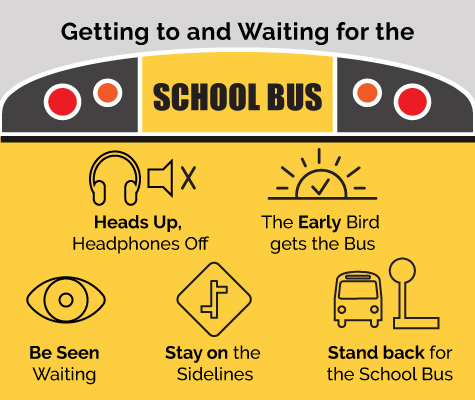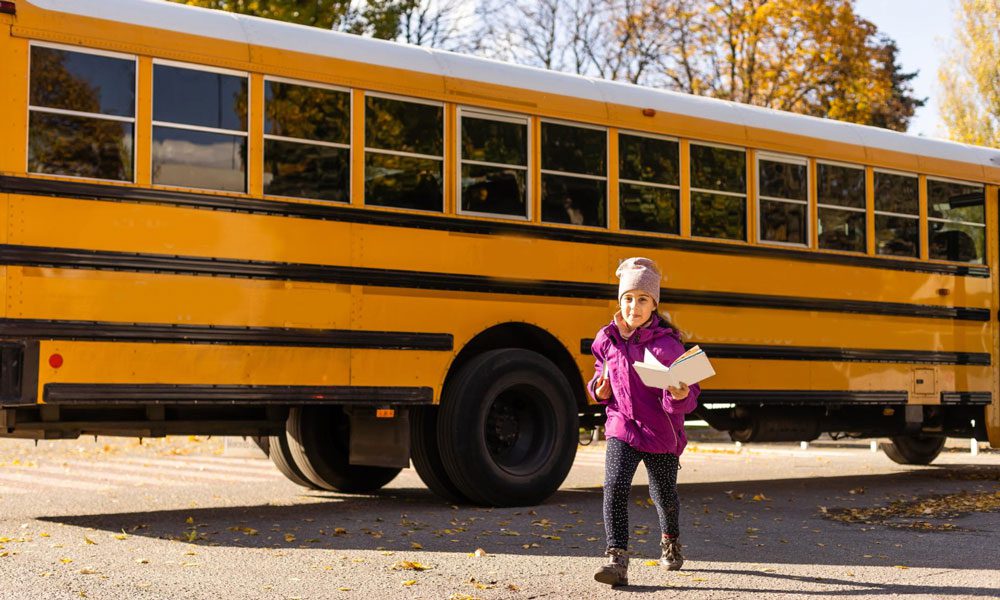Back-to-School Safety Zone Checklist
360 degrees of Safety around the School Bus
64% of the school-age pedestrians fatally injured in school-transportation-related crashes in the last decade were struck by the school buses themselves. (NHTSA, Traffic Safety Fact Sheet, 2017)
Two deadly contributors to these preventable accidents are:
1) Driver Distraction and
2) Vehicle Blind spots
Whether we are drivers, pedestrians, or passengers, we all grow comfortable in our surroundings. Our everyday routines (driving to work, catching a school bus or walking to the bus stop) become the foundation for habits that, more often than not, are conducted in “autopilot mode.”
Not being fully present while navigating traffic is commonplace. But given the number of accidents attributed to distraction, looking for ways to be more aware and more present would go a long way towards increasing safety around any vehicle and even more so around the school bus.
So how can we prevent accidents and raise awareness of school bus safety best practices? The first step is educating drivers, students, and parents on safety in the school bus danger zone.
New (School) Year, New Habits
Building good safety habits is like mastering a sport: practice makes perfect. Though it is a federal requirement to provide school bus safety training to students at least twice a year, can we expect students to remember and practice tips they are reminded of twice a year? Can we expect full adherence to safety initiatives when on average it takes 21 days to build a habit?
Seon has long been at the forefront of developing school bus safety solutions. Over the past two years, we’ve worked tirelessly together with Safe Fleet’s Advanced Technology Group to develop innovative technologies to help bring the number of fatalities in the danger zone to zero. These technologies will alert drivers and students to help prevent accidents. We want to turn the danger zone into the safety zone.
Look for some of these technologies to come to a school bus near you at NAPT in October 2018.
But you can start today with increasing School Bus safety by teaching drivers, students, and parents a few simple tips for safety in the danger zone.
To kick off the new school year, here is our Back-to-School Safety Zone checklist to review with your students and your transportation team.
For Students
Getting to and Waiting for the School Bus

1. Heads Up, Headphones Off
When walking to the bus stop, watch where you are walking by keeping your head up and headphones off.
2. The Early Bird gets the Bus
Be at your bus stop at least 5 minutes before your scheduled pick-up time.
3. Be Seen Waiting
At your designated bus stop, make sure you are visible.
4. Stay on the Sidelines
Keep the streets clear by staying on the sidewalk or in your designated school bus waiting area.
5. Stand back for the School Bus
When the bus arrives, wait until your bus comes to a complete stop.
Watch and listen for instructions from your bus driver or aide before you approach the bus.
Boarding and Exiting the Bus

1. Stay Out of the Danger Zone
Stay at least 10 giant steps away from the front, sides, and back of the bus.
2. Follow the Bus Driver’s instructions
Wait for the bus to come to a complete stop and watch and listen to the bus driver for instructions. They will let you know when it’s safe for you to move.
3. Use the Handrail
When boarding and leaving the bus, hold onto the handrail while on the stairs.
4. Lock it up or lose it
Anything you want to bring to school, zip it up in your backpack so you don’t lose it.
If you drop it outside the school bus, leave it.
5. Look left, right, and left
Whenever crossing the street or in front of a school bus, always check to your left, right and left to see if it’s safe to go.
For Transportation Departments

1. School Bus Safety Activities in Classrooms
Consider having school bus drivers conduct interactive school bus safety activities in the classroom. This gives school bus drivers the opportunity to engage and build trust with students they may have on their routes. Students also get to practice and learn about safety in fun ways.
2. School Bus Safety and Danger Zone Reviews by the Transportation Team
Hold engaging training sessions to review danger zones and school bus safety. Ask bus drivers to share their stories and tips, accompanied by shining examples from video clips taken from your onboard school video surveillance systems.
3. Around the Bus and Bus Stop Observations
Encourage your drivers to note any changes at their bus stops or around the bus exterior:
Are students easily visible at the stop? Are there any obstructions, like an overgrown bush, that needs to be removed to increase visibility?
Has traffic increased around the stop? What is the cause of this traffic growth?
Is weather or the environment making the waiting area unsafe?
Are there ways you can further reduce blind-spots around the outside of the school bus?
Contemplate adding on a vehicle monitoring system, like our inView 360, to eliminate spots.
These regular observations will be valuable for the transportation team to decide what areas need adjustments, like routing or perimeter safety.
4. Improve Communication with Students on the School Bus route
Along with in-classroom school bus safety sessions, ensure your school bus drivers are:
Checking in with students on their understanding of safety instructions.
Providing praise as positive reinforcement when students practice school bus safety habits.
5. Practice Patience
With so many areas to be diligent and alert about, remember to ask drivers to be patient while on the road.
When in a rush, this feeling of being rushed can be distracting and divert from paying full attention to the danger zone around the school bus.
Growing a culture of proactive safety requires practice and takes time as we overcome old habits. With the start of a new school year, we look forward to the growth of student safety excellence at school and around the school bus, together.
What other Danger Zone safety tips do you teach your drivers and students?




































